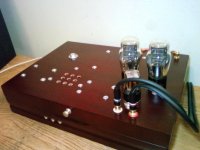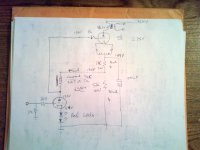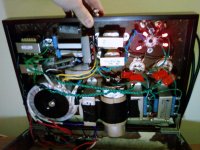I'd like to share my latest project: a single-ended triode amp using the 45 triode. The driver is a choke-loaded 6SN7 that is direct coupled. This allows the 6SN7 to be placed underneath the 45 triode, and steal some of the 45's cathode current (see the crude schematic attached). This idea was outlined in an article on tubecad.com, about a "Safe Loftin-White Amplifier." The power supply, not shown in the schematic, is a simple pi filter with solid-state rectification, using a motor-run capacitor as the last capacitor. The filaments of the 45s are each powered by a dedicated transformer, so I can switch on the filaments to warm them up before I switch on the B+. Everything came together smoothly, and the amp started playing music immediately upon power-on. I got the 45 tubes on Ebay for $40 for the pair -- they weren't tested by the seller, but they looked fresh and beautiful. They sound great to me.
(My signal chain: Apple lossless and 256kB iTunes files on my MacBook, Stereo-Link USB DAC, amplifier, Axiom M3 speakers (which have no crossover components on the woofer, and I replaced the tweeter's electrolytic capacitors with plastic film types).
This amp is great. It puts out about two watts, which is plenty loud for me in my smallish room. Detail is tremendous, the transients of orchestral snares and timpani are startling in their realism, and reverb sounds very lush and detailed. Voices are natural. One of my favorite test tracks for a lower-watt SET is "No One But You," from Yo-Yo Ma's Goat Rodeo Sessions. This track has a male and female vocalist, singing quietly, accompanied by piano, mandolin, violin, and cello, all recorded very naturally. On my system, the music is downright spooky -- soundstaging is excellent and everything sounds immediate and present. The sense of air and the hollow resonance of the mandolin really come through.
Noise is actually very low -- I can hear hum with my ear placed inches from the speaker cone, but in the room I can't hear anything. Bass is weaker than the amp I had before (Gary Kaufman's direct-coupled 6EM7 amp), but everything else is better. Of course, this amp can't roar like my Scott 299C, but it handles even modern, highly detailed and dynamic orchestral recordings very well (For example, Rattle conducting Mahler's 2nd). I've read so much about how great the 45 is, and now I can believe the hype.
Best of all, this was a budget-friendly amp. With the cheap tubes and budget transformers, I spent maybe $250 - $300 total, including the "enclosure:" a cheap silverware chest.
What a great, screwy hobby this is.
(My signal chain: Apple lossless and 256kB iTunes files on my MacBook, Stereo-Link USB DAC, amplifier, Axiom M3 speakers (which have no crossover components on the woofer, and I replaced the tweeter's electrolytic capacitors with plastic film types).
This amp is great. It puts out about two watts, which is plenty loud for me in my smallish room. Detail is tremendous, the transients of orchestral snares and timpani are startling in their realism, and reverb sounds very lush and detailed. Voices are natural. One of my favorite test tracks for a lower-watt SET is "No One But You," from Yo-Yo Ma's Goat Rodeo Sessions. This track has a male and female vocalist, singing quietly, accompanied by piano, mandolin, violin, and cello, all recorded very naturally. On my system, the music is downright spooky -- soundstaging is excellent and everything sounds immediate and present. The sense of air and the hollow resonance of the mandolin really come through.
Noise is actually very low -- I can hear hum with my ear placed inches from the speaker cone, but in the room I can't hear anything. Bass is weaker than the amp I had before (Gary Kaufman's direct-coupled 6EM7 amp), but everything else is better. Of course, this amp can't roar like my Scott 299C, but it handles even modern, highly detailed and dynamic orchestral recordings very well (For example, Rattle conducting Mahler's 2nd). I've read so much about how great the 45 is, and now I can believe the hype.
Best of all, this was a budget-friendly amp. With the cheap tubes and budget transformers, I spent maybe $250 - $300 total, including the "enclosure:" a cheap silverware chest.
What a great, screwy hobby this is.
Attachments
Nice! I have already seen this kind of schematic, called "Free lunch" or "Monkey". Glad to hear from you that it sounds good. What output transformers did you use?
Bypassing the LEDs might be beneficial, have a go with Oscons if you can find some. Bass cut off is a function of your outputs alone or in combination with the anode choke (lacking the necessary inductance). The 45 was my first build in 2001 and I still recall the thrills. At that time my psu was generating some extra low notes that were not in the music but impressive it was. Enjoy it man!
I used the cheapest, smallest Edcor transformers (I previously built Gary Kaufman's 6EM7 DC amp, and I dismantled it to built this one). Because this is only a 2 watt amp, I'm pretty sure that the bass response is adequate. Speaking of bass response, I've been analyzing my music using GarageBand's spectrum analyzer. I've come to the conclusion that for everything but techno and electronic pop, there's little energy below 40Hz or so, and even bass-heavy tracks peak at 40-70Hz. Because human hearing sensitivity drops off precipitously as you go down in bass, any low bass content (<40Hz) must actually be much higher than mid-bass to be audible. So, I'm not a stickler for super bass.
Thanks for the tip on Oscons! I'd never heard of them. Too bad they don't come in, say, 80uF at 500V for power supplies.
Thanks for the tip on Oscons! I'd never heard of them. Too bad they don't come in, say, 80uF at 500V for power supplies.
hi ewong, what is the value on the resistor of grid of 45 that connects to plate of 6SN7 ? also the resistor on input to ground ? what are the power ratings? thanks.
The grid resistor for the 45 is 1k, although this value isn't critical, and you might not even need any resistor there -- grid-stopper resistors are intended to prevent oscillation at high frequencies in high-transconductance tubes (they form a lowpass filter with the miller capacitance of the tube). The input resistor is 1M, which is a standard value -- you could omit this resistor if you use a volume control. This amp generates about 2 watts per channel. Oh -- the power ratings of these two resistors are nothing special -- 1/2 watt, but they dissipate practically no energy, so use whatever you normally would.
Last edited:
The LEDs are at the cathode of the triode, so the entire current of the tube (6mA) passes through them. I did not use a hum pot, and I do use AC on the heaters. Each 45 gets its own filament transformer, and the center tap of the transformer is connected to the resistors and electrolytic bias capacitor as shown in the schematic. I also attached a 0.47uF orange drop capacitor from each pin of the 45's cathode to ground (this isn't on the schematic, but you can see the orange drops in the photo). This gives the high frequencies a more direct path to ground, without having to deal with the inductance of the filament transformer. Others may prefer a hum pot or some other arrangement.
OS-CON is an aluminium type capacitor with an organic semiconductive type electrolyte.
Capacitors Plus, Incorporated - A passive electronic components stocking distributor for Sanyo, Nichicon, Nemco and Jamicon
Capacitors Plus, Incorporated - A passive electronic components stocking distributor for Sanyo, Nichicon, Nemco and Jamicon
There is absolutely no need or benefit in bypassing a bias LED with electrolytic capacitor.
Maybe, it could be argued, a small value film cap would be benecial. 100nF or so, to shunt possible high frequency noise. I haven't personally found any such noise even with headphones, so no need to bypass LEDs in any way.
There is another issue, however. 6mA is not sufficient bias current for most LEDs. It should be at the very least 10mA, preferably 12 to 15 mA minimum. The LED will act as constant voltage source only when sufficient current is available.
If the tube can't deliver that current, use a resistor from B+ to get it. If you don't have a clean B+ (regulated), then I'd use a CCS from B+ to LED to deliver the extra current.
Maybe, it could be argued, a small value film cap would be benecial. 100nF or so, to shunt possible high frequency noise. I haven't personally found any such noise even with headphones, so no need to bypass LEDs in any way.
There is another issue, however. 6mA is not sufficient bias current for most LEDs. It should be at the very least 10mA, preferably 12 to 15 mA minimum. The LED will act as constant voltage source only when sufficient current is available.
If the tube can't deliver that current, use a resistor from B+ to get it. If you don't have a clean B+ (regulated), then I'd use a CCS from B+ to LED to deliver the extra current.
why not just use a single resistor instead of LED, it works the same and is proven to work. what is wrong with resistors?
A properly biased LED can approximate fixed bias much better than RC bias.
I'd use unbypassed resistor cathode bias only with a gyrator or CCS plate load.
'Working' is not the same as better, or less distortion or whatever. Resistor bias does indeed work, but it's by no means the best.
LED bias is a cheap and simple alternative to fixed bias. I use it sometimes when working with really tight space, where no negative bias supply can be fitted.
If the bias current is a problem, a cheap solution is using a single LED for both channels. So 6mA + 6mA = 12mA, which will bias the LED ok.
I'd use unbypassed resistor cathode bias only with a gyrator or CCS plate load.
'Working' is not the same as better, or less distortion or whatever. Resistor bias does indeed work, but it's by no means the best.
LED bias is a cheap and simple alternative to fixed bias. I use it sometimes when working with really tight space, where no negative bias supply can be fitted.
If the bias current is a problem, a cheap solution is using a single LED for both channels. So 6mA + 6mA = 12mA, which will bias the LED ok.
A resistor needs a bypass capacitor. Nobody likes capacitors. LEDs are just as proven but they don't need any capacitor! 🙂why not just use a single resistor instead of LED, it works the same and is proven to work. what is wrong with resistors?
... If the bias current is a problem, a cheap solution is using a single LED for both channels. So 6mA + 6mA = 12mA, which will bias the LED ok.
LED biassing on too low current will result in an "audio signal related" residual voltage on the cathode, which a low-ESR cap can undo. Upping the current from the PS might seem the better engineering solution but how about injecting noise that way?
Good point about combining channels because AC would theoretically be nil. How's practice, no influence measurable?
In practice this effect is entirely negligible compared with the inherent nonlinearity of the valve. LED bias is essentially distortionless even at low currents.LED biassing on too low current will result in an "audio signal related" residual voltage on the cathode
- Status
- Not open for further replies.
- Home
- Amplifiers
- Tubes / Valves
- My New 45 SET (choke-loaded 6SN7, direct-coupled)


